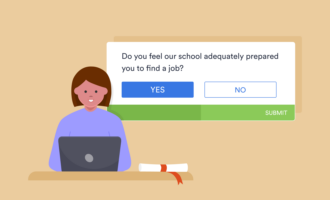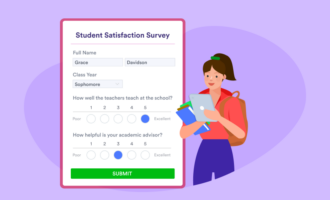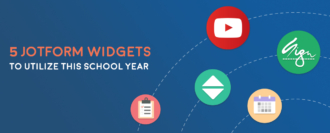Key benefits of data collection in education
- Better conversion
- Higher student retention
- Personalized instruction
- Proactive approach
- Clearer understanding of correlation
- More transparency among stakeholders
- Longer-term relationships
Data collection helps educational institutions gain a deeper understanding of their prospective and current students. It can also provide some insight into educators and how effective their curricula are. With the support of educational technology, data collection becomes even more efficient and insightful, enabling institutions to make informed decisions based on real-time feedback. In addition, data collection in education can help institutions learn more about how engaged their community is.
Discover the importance of data collection, the advantages it provides educational institutions, and how to collect data using the right software in this article.
The importance of data collection in education
Why is data important in education? Educational institutions rely on data to help them make better decisions and provide the best outcomes for their students. The types of data these institutions may collect includes information about enrollment, such as the number of students enrolled, student demographics, and whether enrollment is trending up or down.
Educational institutions also gather data on rates of course completion, student engagement, attendance, and graduation. The school may track teacher reviews, teacher feedback, and teacher retention rates.
Collecting data helps educational institutions improve outcomes for students. For example, if course completion rates are continuously falling, graduation rates may also begin to fall. The school can look at teacher reviews to see which teachers have lower course completion rates and provide them with coaching so they can better support their students.
“The type of data collected also depends on the type of institution, such as public, private, or higher ed,” says Hilary Morris, associate director of communications at Stuart Country Day School of the Sacred Heart.
“When it comes to private schools, for example, we are a business, so we have to think like a business for our marketing approaches. All of our prospecting and media buying decisions are based on data we collect.”
Key benefits of data collection in education
There are many advantages to data collection in education, for both students and teachers. These include
- Better conversion: “We use a simple intake form to understand how families come to us,” says Morris. “Since we know that most families come to us from word of mouth, we can use this data to support our decision-making. We do surveys with families to learn what they’re interested in, which helps plan our marketing efforts.”
- Higher student retention: “Every business knows that it’s more affordable to keep an existing customer happy than to look for new customers,” says Morris. “For our enrollment efforts, we do a Net Promoter Score survey through an online form to learn how our current families feel and whether there are any emerging trends we should address.”
- Personalized instruction: Teachers may collect data about learning styles in their classes to better present material to their students. For example, lessons may be available in live lectures or in written format for those who absorb material better by reading.
- Proactive approach: Institutions can spot roadblocks to success before they happen. For example, if teacher reviews are poor, it may affect student course completion rates or even graduation rates. By tracking certain metrics, schools can resolve issues before they snowball.
- Clearer understanding of correlation: By tracking a number of different metrics through data collection in education, schools can begin to spot relationships between certain KPIs they may not have previously known about. This enables them to pivot in order to improve outcomes.
- More transparency among stakeholders: When administrators of an institution are collecting data from students, teachers, parents, and other stakeholders, it’s important to share why they’re collecting the data. This openness and transparency helps stakeholders understand the efforts the educational institution is taking to improve student outcomes.
- Longer-term relationships: “When a family leaves us, whether it’s because [the student] graduate[s] or move[s] or change[s] schools, we collect data to learn more about their interests now that their role with us has changed,” says Morris. “This information can help us with future planning efforts.”
Education data collection: 3 key questions
1. What types of data do educational organizations collect?
Educational institutions collect many different types of data through various methods:
- Enrollment numbers
- Grades from quizzes, tests, and other assessment tools
- Course completion rates
- Graduation rates
- Attendance rates
- Demographics (like age, race, gender, economic status, and special education needs)
- Engagement levels
- Teacher observations
2. Why is education data collection important?
“It’s impossible to help students without understanding exactly where they are academically,” says Matt Kirchner, CEO of academic tutoring and test preparation company Revolution Prep.
Every educational institution should make it a priority to ensure students reach their potential and achieve their goals. Acquiring and analyzing education data is essential to making this happen. This is where assessment tools like tests come in handy.
Kirchner notes that data also enables educators to identify trends and patterns that drive their strategies. For example, if you find that students’ grades steadily decline in the winter months, you can consider providing extra help to children during that time of the year.
“Without concrete data,” he says, “we’d be making these decisions based on assumptions, which wouldn’t necessarily lead to the best outcome for students.”
Data is important for students and educators, but it’s also beneficial for parents. Kirchner says parents are often concerned about whether their children are keeping pace in class. While data alone won’t completely erase those concerns, it can certainly help inform parents and serve as a warning sign that their children may need a bit of extra help.
“Parents might then choose to invest in, say, private tutoring,” Kirchner says.
Kirchner’s sentiments about the importance of education data collection align closely with those of Arash Fayz, the executive director of LA Tutors 123, a test preparation and private tutoring company based in Los Angeles. He notes that educational organizations can collect and analyze data not only to identify individual student needs, but also to identify underserved demographic groups.
“Results from these analyses can be applied in the pursuit of more accessible education for a specific group — or even toward undoing past imbalances in educational opportunity,” Fayz says.
Again, Fayz echoes Kirchner in noting how beneficial education data collection can be for multiple stakeholders — not just students. “The practice of collecting data across the education spectrum can help identify and address student issues and, subsequently, reduce frustration for both students and parents. It can also reduce stress on faculty and inform administrators on the best resources to make available to other education stakeholders,” he explains.
3. What solutions are available to help with education data collection?
Whether it’s helping with test distribution and collection or keeping up with attendance, plenty of relevant solutions are available to educational institutions.
Jotform, an easy-to-use form builder and data-collection solution, focuses heavily on education. Jotform provides teachers and administrators across the educational spectrum — from grade schools to universities — with an easy solution for collecting information on students and their education.
Educators use Jotform to collect and analyze data for a variety of purposes. For example, they create
- Online quizzes
- Extracurricular signup forms
- Field trip permission forms
- Class registration forms
- Course evaluation forms
The data-collection process with Jotform
One of the most effective ways for any educational institution, from primary schools to universities, to collect data is with Jotform. This intuitive software is both simple and easily customizable, so educational institutions can create secure forms, gather information from stakeholders, and gather insights from the data.
From an administrative standpoint, Jotform is useful for scholarship applications, alumni donations, class registration, event registration, course evaluations, and many more types of applications.
In the classroom, Jotform is the perfect solution for homework submission forms, online quizzes, extracurricular signup forms, student surveys, and more. The easy-to-use templates are fully customizable to each school’s needs, and the drag-and-drop builder is instinctive and simple.
“It all boils down to not shooting in the dark,” says Morris. “Whatever kind of data you’re collecting, it helps you make educated, strategic decisions for the school.”
Now that you know why data is important in education — and how you can effectively gather data from students, teachers, and other stakeholders — it’s time to get started with Jotform.
Photo by ThisisEngineering RAEng on Unsplash








































































































Send Comment: